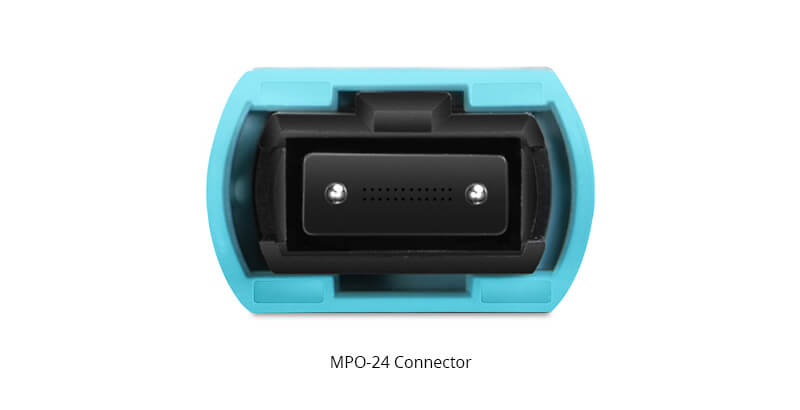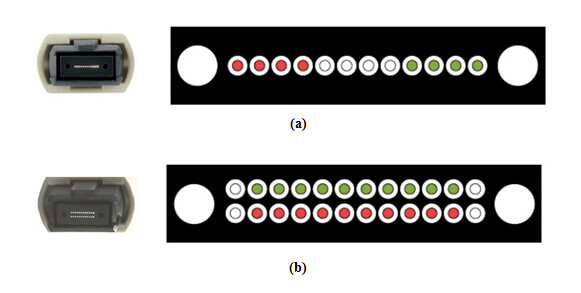Nowadays, In the data centers, tremendous amount of business data needs to be transmitted, processed and stored. So many data center are migrated to 40/100 GbE (Gigabit Ethernet) from 10 GbE in order to meet the increasing demands on high speed and bandwidth. Under such circumstances, many have looked to 24-fiber MPO style connector as the ideal migration solution in the data center. Using 24-fiber MPO cabling solution throughout an entire channel provides extra flexibility, as users can easily migrate from 10G to 40G or 100G by simply swapping out the connectivity at the end of the channel. Pre-terminated cabling using 24-fiber MPO connectors provides double the density of 12-fiber MPO cabling in the same footprint, reducing the cabling required, allowing for fewer cable pathways, and improving airflow in data centers.
What is 24-Fiber MPO Trunk Cable?

The MPO-24 connector is perhaps the most cost effective method to deploy both parallel and duplex fiber optic applications. With twenty-four fibers in a single connector it provides
additional density versus three MPO-8 connectors or two MPO-12 connectors, and expedites the cleaning and inspection time associated with the installation of the MPO systems. The method B trunk cables manage the port polarity in a similar fashion to the MPO-8 and MPO-12. The cross connection of MPO-24 trunks provides much higher port densities, reducing panel space requirements by 3:1 compared to MPO-8 and 2:1 compared to MPO-12. In high density applications, the trunk cable size is often a consideration as well. A 144-fiber trunk cable using MPO-24 subunits occupies approximately 30 percent less area than the MPO-12 equivalent. The 24 fiber MPO connector is able to deliver three individual 40G links. This includes a single 100G link, or a 120GB link using QSFP+ & CXP transceivers.
Why 24-Fiber MTP/MPO trunk cable the ideal migration solution for 10g to 40g/100g?
In 2002, the IEEE ratified the 802.3ae standard for 10 GbE over fiber using duplex fiber links and vertical cavity surface emitting laser (VCSEL) transceivers. Most 10 GbE applications use duplex LC style connectors where one fiber transmits and the other receives. Standards efforts aimed at finding a cost-effective method to support next-generation speeds of 40 and 100 Gbps, and in 2010, the IEEE ratified the 802.3ba standard for 40 and 100 GbE. Similar to how transportation highways are scaled to support increased traffic with multiple lanes at the same speed, the 40 and 100 GbE standards use parallel optics, or multiple lanes of fiber transmitting at the same speed. Running 40 GbE requires 8 fibers, with 4 fibers each transmitting at 10 Gbps and 4 fibers each receiving at 10 Gbps. Running 100 GbE requires a total of 20 fibers, with 10 transmitting at 10 Gbps and 10 receiving at 10 Gbps. Both scenarios call for using high-density multi-fiber MPO style connectors.

For 40 GbE, a 12-fiber MPO connector is used. Because only 8 optical fibers are required, typical 40 GbE applications use only the 4 left and 4 right optical fibers of the 12-fiber MPO connector, while the inner 4 optical fibers are left unused as shown in Figure 1.a
To run 100 GbE, two 12-fiber MPO connectors can be used one transmitting 10 Gbps on 10 fibers and the other receiving 10 Gbps on 10 fibers. However, the recommended method for 100 GbE is to use a 24-fiber MPO style connector with the 20 fibers in the middle of the connector transmitting and receiving at 10 Gbps and the 2 top and bottom fibers on the left and right unused as shown in Figure 1.b
A 12-fiber MPO/MTP connector is used for 40 GbE (data rate up to 40Gbps, 4 x 10 Gbps). But among the 12 fibers, only 8 optical fibers are required—4 for Tx and 4 for Rx, and each channel has a transmission rate of 10 Gbps (usually use the 4 left and 4 right optical fibers, and the inner 4 optical fibers are left unused). And for 100 GbE (data rate up to 100 Gbps, 10 x 10 Gbps or 4 x 25 Gbps), there are two solutions. One is to use two 12-fiber MPO/MTP connectors, one transmitting 10 Gbps on 10 fibers and the other receiving 10 Gbps on 10 fibers. The other one is to use a 24-fiber MPO/MTP connector. Among the 24 fibers, only 20 fibers in the middle of the connector are used to transmit and receive at 10 Gbps and the 2 top and bottom fibers on the left and right are unused.
The advantages of 24-Fiber MTP/MPO trunk cable in 10g to 40/100 GbE Migration solution
Advantage 1: Maximum Fiber Utilization
Using 24-fiber trunk cables with 24-fiber MPO/MTP connectors on both ends to connect from the back of the switch panel to the equipment distribution area can maximum the fiber utilization. For 10G applications, each of the 24 fibers can be used to transmit 10 Gbps, for a total of 12 links. For 40G applications, which requires 8 fibers (4 Tx and 4 Rx), a 24-fiber trunk cable provides a total of three 40G links. For 100 GbE, which requires 20 fibers (10 Tx and 10 Rx), a 24-fiber trunk cable provides a single 100G link (24-fiber solution is the more recommended configuration to used for 100 GbE than 12-fiber solution). This recoups 33% of the fibers that would be lost with 12-fiber trunk cables, providing a much better return on investment.
Advantage 2: Reduced Cable Congestion
24-fiber trunk cables provide more amount of fiber in less space. For instance, it takes three 12-fiber trunk cables to provide the same number of links as a single 24-fiber trunk cable—or about 1-1/2 times more pathway space for a 40G application.
Advantage 3: Increase Fiber Density
Density in fiber switch panels is critical as today’s large core switches occupying upwards of 1/3 of an entire rack. 24-fiber MPO connectors offer a small footprint which can ultimately provide increased density in fiber panels at the switch location. In addition, with fanout technology, a 24-fiber MPO patch cable can be designed with a 24-fiber MPO on one end and 12 duplex LCs on the other end which is an ideal solution for high density 40/100 GbE migration.
Advantage 4: Simple and Cost-effective
24-fiber MPO/MTP solution is a simple and cost effective migration path from 10G to 40/100G Ethernet. It effectively supports all three applications—10, 40 and 100 GbE. Data center managers can easily migrate to higher speeds, with less time and complexity, as 24-fiber solution offers guaranteed performance for 10, 40 and 100G applications, upgrading the cabling infrastructure is as simple as upgrading the fan-out cables or cassettes and patch cords to the equipment.
Advantage 5: 24-Fiber Connectors Have Less Insertion Loss
Insertion loss is a critical performance parameter in data center cabling deployments. Lower overall optical loss allows more margin for the network to operate, or in the case for some users, offers the option of more connections for patching locations. The IEEE 802.3ba 40/100GbE standard specifies OM3 fiber to a 100-meter distance with a 1.5 dB total connector loss budget. OM4 fiber for 40/100GbE is specified to a 150-meter distance with a 1.0 dB total connector loss budget. As total connector loss increates, the supportable distance at that data rate decreases. However, with the current trend of moving to distributed access/aggregation data center switch strategies such as Top of Rack (ToR), the prevalence of backbone lengths exceeding 100 meters is dramatically decreasing.
Some have mistakenly claimed that higher fiber count leads to higher loss, and one cable vendor pointed to a “typical” loss of 0.5 dB for 24-fiber connectors as evidence. In fact, the industry standard product rating for MPO/MTP connector performance of both 12-fiber and 24-fiber is 0.5 dB maximum. When using proper polishing techniques, 24-fiber MPO/MTP terminations can meet the same performance levels as 12-fiber assemblies. Improved performance can be achieved using low-loss ferrules for both 12-fiber and 24-fiber MPO/MTP connectors rated at 0.35 dB maximum.
Conclusion
Fewer connectivity components to be replaced or added simplifies migration and reduces costs for both components and installation. Higher-density connectivity leaves more rack space for active equipment. The 24-fiber data center trunking and interconnect solution helps data center managers effectively and efficiently support today’s high-speed requirements. With 24-fiber trunk cables that eliminate the need for complete and complex reconfiguration all the way from the switch to the equipment, it offers an easy, cost-effective method for upgrading from 10G, to 40G and 100G with the least capital and operating expense.
In all, the 24-fiber MTP cabling will future-proof your network, lower your cost and maximize your return on investment.
 EN
EN ES
ES DE
DE